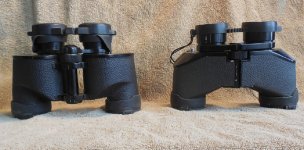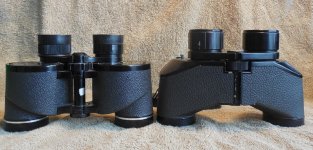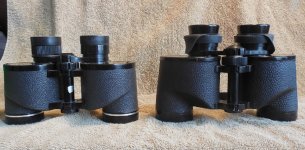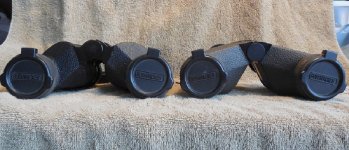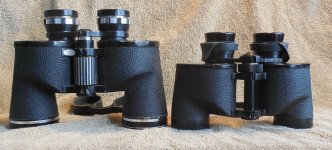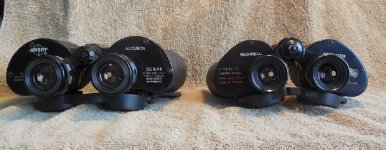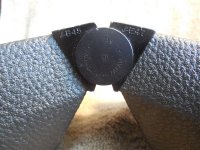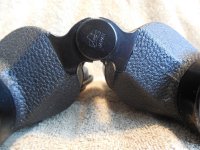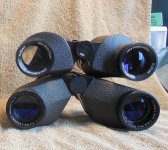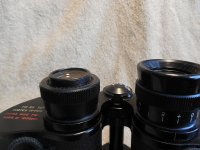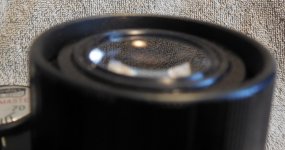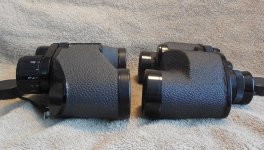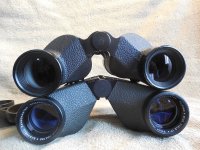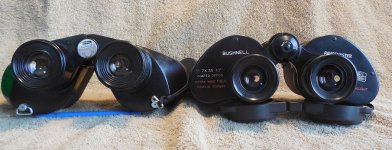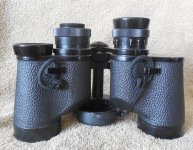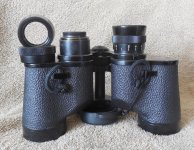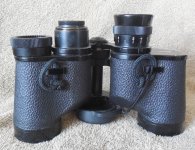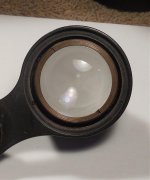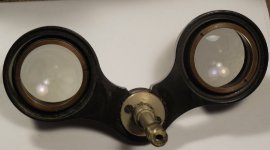Fuji Rangemaster
I was fortunate, I think, to get both these in excellent condition at so close to the same time. I've had active searches going for these for several years. A Fuji early IF model just sold prior to these for $168.50 (plus shipping), which I missed by a dollar. I would have bid higher if they were CF. I am now glad I did not get that one, as these wound up costing $134.49 to my door. This Fuji is in mint condition. There are just a few places where there is some very small finish loss, overall condition externally I would rate them 95%. Internally they are pristine. Collimation is spot on. They are nearly identical in overall dimension, but the unadorned Fuji weighs 33 oz. vs. the Tamron’s 38. With a standard modern style rain guard, Bushwhacker #6 Flip ups, and a small strap, the Fuji scales 35.0 oz. to The Tamron’s 40 oz. In the end, they are both large binoculars, but they will affect different people differently due to the radical difference in housing design.
For what it is worth, the serial number is 311170. When the cap on the objective end of the hinge is removed, there is a number 100. It is not threaded for a tripod adapter.
The prisms seem identical in shape and size in both models, 57 mm long, 27 mm wide, and 25 mm high. Again, apparently interchangeable with the Swift Audubon IIc. I have not taken the Fuji apart to the point where I can get a good picture of the prisms, and I may well not. I need to get a different screwdriver from what I have to remove the outer prism plate, all the drivers I have that fit the screw slot width are too thick for the slot. I was initially not going to remove anything, but the focus had really stiffened up, so I took the ocular assembly off, degreased the focus threads, and added some grease. The focus works smoothly now. Once the ocular assembly is off, one needs to unscrew the ocular tube, remove the three outer prism plate screws and lift the plate off, exposing the prisms. This much can usually be done without causing harm.
Like their Tamron relative, they have a very slight amber color bias, but appear neutral in use. Colors are represented true to their tint, whites are white, reds are red, etc. While they may not seem as bright as a modern multi coated glass, their colors are bright and they have very good contrast and very good apparent sharpness. The colors do not appear washed out. Both the outer surface of the ocular and the objective look coated, there is a darker blue tinge to the objective than there is to the ocular. The coatings appear darker in the Tamron. The objective of the Tamron reflects one image of a light bulb, quite blue in tint. The Fuji likewise reflects a single reflection of a light bulb, but the color of the reflection has a definite pinkish tinge that is different from the Tamron. The oculars of both reveal four image reflections of a light bulb, with a pinkish tint to all four reflections in both binoculars. The reflections appear identical. Like the Tamron, the Fuji shows perfectly round exit pupils, speaking of Bak-4 prisms. The Tamron ocular assembly is larger in diameter than Fuji, 50 mm vs. 38 mm in the Fuji, but the Bakelite screw on eye cups of the Fuji flare out to 40 mm. The Tamron has a more massive bridge, some 15 mm thick, compared to 10 mm for the Fuji. The ocular lenses are 25 mm in diameter in both. There appears to be less mass involved in the Fuji body than in the Tamron, these factors likely accounting for the weight difference. There appears to be equal amounts of glass in both. Both objectives expand to the same width. The IPD range on the Fuji is 52-72 mm.
Oddly enough, both of these Rangemasters focus properly for my right eye at a plus 2 diopter setting. Both diopters seem to have equal travel to both plus and minus sides of the focus when set a 0, so it seem unlikely both somehow managed to slip the same amount in the same direction. Typically, my focus is just slightly to minus one diopter for proper focus. I have no idea why this is.
As far as I can tell, Bushnell registered the Rangemaster name on April of 1952. Mr. Bushnell stated his second trip to Japan was in the spring of 1952. It seems likely he told Fuji at that time to make him the best binocular they could make and he’d buy it. Again, as far as I know, the FPO like mine was an early model, superseded by at least 1957 by a later model that had some silver trim on the outside of the body, on the ocular assembly and rings around the objective barrel ends. Search on eBay reveals common ads for Bushnell Rangemaster binoculars that clearly are dated 1957 and they show a silver trimmed binocular. So with that in mind, I assume these were from sometime between late 1952 and 1956. Upon reflection, I wonder if the 3 in the serial number is reference to 1953. If these are from 1953, then they are in stunning condition for being around 60 years old. The case has wear, but little tear. A little shoe polish and it looks much newer. My only nitpick with the case is it is just a little too small. As I mentioned above, there is some finish wear on the metal body parts, but this binocular has not been used very hard. There is no silver oval for inspection by the Japan Telescopes Inspection Institute (JTTI), just an FPO over a logo and a Japan stamped on the cover of the objective end of the center rod. There are no J-B or J-E numbers, so my assumption is that these predate the JTTI period, which, as far as I know, required the use of the J-B and J-E numbers from November 1959 onward. I have no idea when the Fuji model was replaced by the Tamron model.
The Rangemaster was good enough evidently to be purchased in small numbers during Vietnam for use in counter intelligence work. Likely the Fuji, but I don’t know for sure.
The Fuji has a 10*(525’) field. The edges are better than the Tamron and the sweet spot on both binoculars seems about the same 8*, more or less. There is some 14 mm eye relief on the Fuji, a lot better than the Tamron. It seems a simple matter, viewed from the perspective of hindsight, to say it looks like it would have been pretty easy to make the oculars so that the eye glass wearer could get closer to the lens, particularly with the Tamron. The Fuji would be pretty easy to extend the eye cup upward. The eye cups have ample thread to let them have enough for secure purchase by screwing them out a couple of millimeters. It would be best to find, or have a machine shop make a few bushings to place underneath the eye cup so they could be screwed down tightly.
Both seem to focus to the same 12 foot close distance. The Fuji is counterclockwise to infinity, reverse of the Tamron. The Fuji has better apparent depth of field than the Tamron, while I’d give the Tamron a slight edge in brightness.
Field and Edge performance:
I’ll start here because the dominating aspect of the view in both of these is the very wide field and the tremendous depth of these 7x binoculars. Finally, considering width and depth of the field, is the edge performance of the two. Both of these seem to show me a better edge by quite a bit than other equally wide angle vintage porros. The edge of the Fuji is superior to the edge of the Tamron, but the sweet spots on both is about a wash, so there seems to be no practical advantage to the extra degree in the Tamron. It has been said the Fuji is perhaps the best wide angle porro ever produced. I agree with that sentiment. The Tamron I have is only a very small nitpick behind. The feature that really puts the Fuji in front is its superb depth of field. Yes, I realize there should be no difference, but the Fuji is in dead bang, spot on target, in focus from 100’ to infinity. The Tamron is basically there too, but it requires an occasional bump of the focus in the close end that the Fuji seems not to need. The combination of width and depth is the best I have seen for myself with these Rangemasters.
Object and Image Performance:
These are both equally sharp, bright, and possess very good contrast. The color rendition in both is neutral to perhaps ever so slightly cool. There is a fair interest in older Swift vintage porros. I have a few of those myself, and for those familiar with the model 804 Audubon, you have a good idea of the image of these Rangemasters. The balance in the width, depth, resolution, color, and contrast are pretty well balanced. The view is pretty much like you walked up closer to the target. It is relaxing, stress free, and pretty relaxing. They both display what has been widely referred to as a “picture window view”. These look like that, but a bigger window. With both, there is ample optical horsepower to get any detail needed for either an ID, or to just plain enjoy the view. While the colors are not as saturated as a fully equipped modern glass, the image looks, to me anyway, anything but washed out. Colors are rendered through the binocular just as you would see them with the unaided eye if the target was just in front of you. I’m not sensitive to CA, but it seems a non-issue with these.
I really was satisfied at the view I got from these. They are superior to most of my other old porros. The Fuji in particular was a surprise, since there is every indication this binocular is likely sixty years old. Point a gun at me and force me to pick one, I think it would somewhat begrudgingly be the Fuji. Largely because the Fuji is a bit easier to handle and has better apparent depth. Eye relief is not an issue for me with either, but if you wear glasses, the Fuji would probably be the way to go. Heft either of these and you immediately note a solid, substantial, quality feel that bespeaks of a lot of good old fashioned skill. I’m still trying to come to grips with the idea that this Fuji Rangemaster is from the 1950’s! It is enough to make me wonder just what level of improvement we have really achieved.

It always makes me wonder when I hear the statement that a particular binocular… “Blows another away” :eek!:. That always seems like the players in a divorce proceeding trying to make the other side look terrible by saying bad things while justifying their own stance. I personally don’t think there is much that blows anything else away. So while I concede these ancient, single coated binoculars are not at the level of modern multi coated stuff, they are not getting “blown away” by anything. Certainly many viewers will think the modern stuff is better, and that’s fine, even to be expected, I’m just trying to keep things in perspective here. Single coated, decades old, ye gads look at the view! Either one (aside from sheer size) I could easily use as an only binocular, even today. At times, I will do just that too.

I'll post some pictures next, and possibly some dissassembly related things. B





